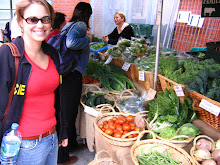 The point of this blog is to demonstrate how people the world over are working together to grow, cook and eat their own food. Also known as food sovereignty movements, the idea is to disengage from the capitalist world economy of food to the greatest degree possible and to produce and distribute food as community effort.
The point of this blog is to demonstrate how people the world over are working together to grow, cook and eat their own food. Also known as food sovereignty movements, the idea is to disengage from the capitalist world economy of food to the greatest degree possible and to produce and distribute food as community effort.Thus far, I have featured some growing, some cooking and lots and lots of eating. (Dear reader, in case you are wondering, I don't weight 300 pounds. Yet.) In every case, no one cooking the food actually grew it, and in most cases the people eating it didn't have much to do with growing it OR cooking it. This is how our food system works.
I understand the reasons for this of course. It's hard work to grow food. And it takes a long time to learn how to cook properly. Everyone eats of course, and this is the reason we should take a bigger role in where food comes from. We know precious little about the food we put in our bodies, and in so doing, we unwittingly consume toxins of all kinds-unfair labor practices, extortion of profit from farmers to multi-nationals and poisons of all kinds peddled in the name of efficiency.
 Even here at Navdanya the roles of cooking and growing are segregated. The cooks, Satya, Kamal and Ramji never do field work. The field workers, Sunil, Jai Singh and Jeet don't really help much in the kitchen. Few of the volunteers are really here long enough to see food from seed to table, and even those are not really involved in cooking. Satya is a formdible force to reckon with in the kitchen. Small, soft-spoken and sweet he might be, and try as I might to win him, he doesn't suffer fools messing with his cooking.
Even here at Navdanya the roles of cooking and growing are segregated. The cooks, Satya, Kamal and Ramji never do field work. The field workers, Sunil, Jai Singh and Jeet don't really help much in the kitchen. Few of the volunteers are really here long enough to see food from seed to table, and even those are not really involved in cooking. Satya is a formdible force to reckon with in the kitchen. Small, soft-spoken and sweet he might be, and try as I might to win him, he doesn't suffer fools messing with his cooking.In any case, Navdanya does function as a collective, and much of the food we eat has been produced here on the farm. Just today I saw a huge pile of bhindi (okra) sitting on the kitchen counter. My guess is that we'll have some kind of bhindi subji for supper. Every day for lunch and dinner we eat pulses (lentils) that are all produced here on the farm, grown from seeds saved in the seed bank and collected for generations by farmers. We also eat rice every day-and a large part of the farm is dedicated to growing rice and wheat, both for our consumption and for seeds for the seed bank. Jai Singh brings jack fruit fresh from the tree on occasion, and although I'm not a fan of it much, I do like it deep fried with salt and chili powder. What's not to love? One day when I asked for a lemon, Jai Singh waved his hand in the direction of the mango orchard. When I didn't understand, he harumphed and took me out to the lemon trees. Duh. And every day now, after much wheedling, we have mangoes from the orchard for breakfast.
 Roles reversed a bit last Friday because Massi, a traveler from Italy, had whipped us all into a frenzy talking about pizza. Pizza. Pizza. Pizza. It was enough to drive us all mad. So, it was Sarayu's last day at Navdanya, and since she and Massi love a good party, we splurged and bought vegetables from the Friday night market in the local village, cheese and olives from the imported food store in Dehradun and picked mangoes from the orchard on the farm.
Roles reversed a bit last Friday because Massi, a traveler from Italy, had whipped us all into a frenzy talking about pizza. Pizza. Pizza. Pizza. It was enough to drive us all mad. So, it was Sarayu's last day at Navdanya, and since she and Massi love a good party, we splurged and bought vegetables from the Friday night market in the local village, cheese and olives from the imported food store in Dehradun and picked mangoes from the orchard on the farm.Massi took over the kitchen and poor Satya was left to wonder what happened. Kamal, master chapati maker, rolled out superb pizza crusts with atta (whole wheat) flour. Dozens of pizzas emerged from the kitchen, three at a time and were greedily consumed by us foreigners, and skeptically sampled and enjoyed with increasing enthusiasm by the kitchen and field workers. All that was missing was beer.


My favorite pizza of all--and Massi's masterpiece--was the mango pizza. The onions, garlic, basil, wheat and mangoes were all from the farm, and the tomatoes came from local farms. Without cheese, it was superb, made even better by the joy and mystery of sharing the magic of food and fellowship.
Together, we grew, cooked and ate.

No comments:
Post a Comment